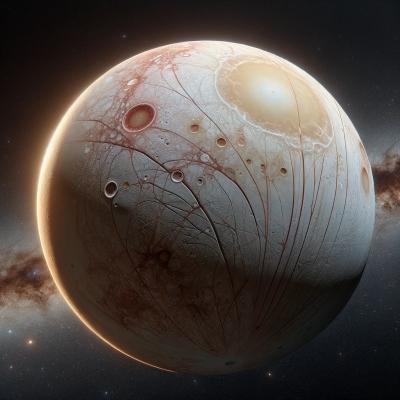
The quest to uncover extraterrestrial life takes a fascinating turn with a groundbreaking study by the University of Washington in Seattle and the Freie Universität Berlin. This research highlights the intriguing potential of ice grains in space ejected from celestial bodies like Europa and Enceladus to carry signs of life. As NASA gears up for an ambitious mission to Europa, this study sheds light on the cosmic breadcrumbs that may lead us to discover life beyond Earth.
Europa and Enceladus: Moons with Mysteries
Europa, one of Jupiter's largest moons, and Enceladus, orbiting Saturn, are celestial enigmas wrapped in ice. Both moons are believed to harbor subsurface oceans beneath their icy shells, making them prime candidates in the search for extraterrestrial life. The ejection of ice grains from these moons into space offers a unique opportunity to study the materials that lie beneath their surfaces without having to drill through miles of ice.
How Ice Grains in Space May Unveil Secrets of Life
The study posits that ice grains in space ejected from Europa and Enceladus could contain organic compounds or even microorganisms, encapsulated within their icy confines. These grains, once liberated into space, could be analyzed by spacecraft equipped with the right instruments, providing invaluable insights into the conditions and potential for life on these moons.
NASA's Upcoming Mission to Europa
NASA's planned mission to Europa aims to delve deeper into these mysteries. The mission will send a spacecraft to conduct a detailed reconnaissance of Europa's ice-covered surface and investigate its subsurface ocean, believed to be one of the most promising places to find life in our solar system. This mission will also pay close attention to the ice grains ejected into space, utilizing advanced instruments to analyze their composition for signs of life.
Technological Marvels at the Forefront of Discovery
The instruments slated for the Europa mission represent the pinnacle of current space exploration technology. They are designed to detect the faintest whispers of organic material within the ice grains in space, offering a window into the moon's hidden ocean. The ability of these instruments to parse the secrets held in ice grains could significantly advance our understanding of life's potential on Europa and Enceladus.
A New Chapter in the Search for Life
The collaborative study between the University of Washington and Freie Universität Berlin, coupled with NASA's upcoming mission to Europa, marks a pivotal moment in our quest to find life beyond Earth. By focusing on the ice grains ejected from moons like Europa and Enceladus, scientists hope to unlock the mysteries of these icy worlds, inching ever closer to answering the eternal question of whether we are alone in the universe.
The cosmos continues to beckon, urging us to unravel its mysteries. As we stand on the brink of potentially discovering extraterrestrial life, the study of ice grains from Europa and Enceladus serves as a beacon of hope, guiding us toward a future where the possibilities are as boundless as the universe itself.
